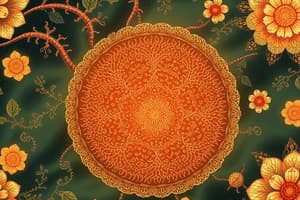Podcast
Questions and Answers
Which branch of life science investigates the chemical processes occurring within living organisms?
Which branch of life science investigates the chemical processes occurring within living organisms?
- Cell Biology
- Biochemistry (correct)
- Genetics
- Ecology
What is the process by which cells break down glucose to release energy in the form of ATP?
What is the process by which cells break down glucose to release energy in the form of ATP?
- Photosynthesis
- Cellular Respiration (correct)
- Protein Synthesis
- DNA Replication
Which of these is NOT a key concept in life science?
Which of these is NOT a key concept in life science?
- Gravity (correct)
- Growth and Development
- Homeostasis
- Evolution
What is the process by which organisms maintain a stable internal environment despite changes in the external environment?
What is the process by which organisms maintain a stable internal environment despite changes in the external environment?
Which of these is NOT a branch of life science?
Which of these is NOT a branch of life science?
What is the basic unit of life?
What is the basic unit of life?
Which of the following correctly describes the relationship between organism and population?
Which of the following correctly describes the relationship between organism and population?
Which level of biological organization includes combinations of atoms?
Which level of biological organization includes combinations of atoms?
What is the primary difference between the domains Bacteria and Archaea?
What is the primary difference between the domains Bacteria and Archaea?
What is the process by which plants and some other organisms use sunlight to synthesize foods from carbon dioxide and water?
What is the process by which plants and some other organisms use sunlight to synthesize foods from carbon dioxide and water?
Which of the following is NOT a kingdom within the domain Eukarya?
Which of the following is NOT a kingdom within the domain Eukarya?
Which of the following best describes the relationship between a community and an ecosystem?
Which of the following best describes the relationship between a community and an ecosystem?
Which level of biological organization encompasses all the ecosystems on Earth?
Which level of biological organization encompasses all the ecosystems on Earth?
Flashcards
Tissues
Tissues
Groups of similar cells that perform a specific function.
Organ Systems
Organ Systems
Groups of organs working together to perform complex functions in an organism.
Populations
Populations
Groups of individuals of the same species living in a specific area at the same time.
Biosphere
Biosphere
Signup and view all the flashcards
Taxonomy
Taxonomy
Signup and view all the flashcards
Life Science
Life Science
Signup and view all the flashcards
Cell
Cell
Signup and view all the flashcards
Metabolism
Metabolism
Signup and view all the flashcards
Homeostasis
Homeostasis
Signup and view all the flashcards
Photosynthesis
Photosynthesis
Signup and view all the flashcards
Cellular Respiration
Cellular Respiration
Signup and view all the flashcards
Mitosis
Mitosis
Signup and view all the flashcards
DNA Replication
DNA Replication
Signup and view all the flashcards
Study Notes
Introduction to Life Science
- Life science encompasses the study of living organisms, their structures, functions, interactions, and evolution.
- It includes various interconnected disciplines like biology, ecology, genetics, and more.
- Key aspects of life science include understanding the fundamental processes of life, from molecular interactions to ecosystems.
- Life science uses scientific methods to explore and describe living things.
Key Concepts in Life Science
- Cells: The basic unit of life. All living organisms are composed of one or more cells.
- Metabolism: The chemical processes that occur within a living organism in order to maintain life.
- Homeostasis: The ability of an organism to maintain a stable internal environment despite changes in the external environment.
- Growth and Development: The processes by which an organism increases in size and complexity.
- Reproduction: The process by which organisms make more of their own kind.
Branches of Life Science
- Molecular Biology: Focuses on the structure and function of molecules essential to life, including DNA, RNA, proteins.
- Genetics: Studies heredity and the variation of inherited characteristics.
- Cell Biology: Investigates the structure and function of cells, including their organelles and processes.
- Physiology: Focuses on the functions of organ systems in organisms.
- Ecology: Studies the interactions of organisms with each other and their environment.
- Evolutionary Biology: Examines the processes of evolution and the diversity of life.
- Biochemistry: Investigates the chemical processes occurring within living organisms.
Key Processes in Living Organisms
- Photosynthesis: The process by which plants and some other organisms use sunlight to synthesize foods from carbon dioxide and water.
- Cellular Respiration: The process by which cells break down glucose to release energy in the form of ATP.
- DNA Replication: The process of copying DNA molecules to ensure accurate genetic information transfer during cell division.
- Protein Synthesis: The process of creating proteins from the information encoded in DNA and RNA.
- Mitosis: Cell division for growth and repair.
- Meiosis: Cell division that leads to the formation of gametes (sex cells).
Levels of Biological Organization
- Atoms: Fundamental building blocks of matter.
- Molecules: Combinations of atoms.
- Cells: Fundamental units of life.
- Tissues: Groups of similar cells.
- Organs: Structures composed of different tissues working together.
- Organ Systems: Groups of organs working together.
- Organisms: Individual living beings.
- Populations: Groups of individuals of the same species in a given area.
- Communities: Groups of different populations interacting.
- Ecosystems: Communities of organisms interacting with their physical environment.
- Biosphere: All the world's ecosystems.
Diversity of Life
- Taxonomy: The science of classifying and naming organisms.
- Classification: Grouping organisms based on shared traits, evolutionary relationships (phylogeny).
- Domains of Life (Three-domain system): Bacteria, Archaea, Eukarya.
- Kingdoms (under Eukarya): Protista, Fungi, Plantae, Animalia.
Studying That Suits You
Use AI to generate personalized quizzes and flashcards to suit your learning preferences.




